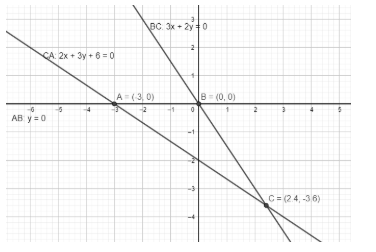
Statement-1: The internal angle bisector of angle C of triangle ABC with sides AB, BC and AC are $y=0,3x+2y=0$ and $2x+3y+6=0$ respectively is, $5x+5y+6=0$ .
Statement-2: Image of point A with respect to $5x+5y+6=0$ lies on side BC of the triangle.
(a). Statement 1 is true, statement 2 is true; statement 2 is correct explanation for statement 1.
(b). Statement 1 is true, statement 2 is true; statement 2 is not correct explanation for statement 1.
(c). Statement 1 is true, statement 2 is false.
(d). Statement 1 is false, statement 2 is true.
Answer
593.7k+ views
Hint: First find the points A, B, C by intersection of sides given in the question. So given an internal angular bisector, the bisector bisects the angle into 2 equal halves hence, it divides the side opposite into 2 parts with ratio of corresponding sides. Equation of angular bisector of two equation of line $ax+by+c=0,dx+ey+f=0$ is given by
$\dfrac{ax+by+c}{\sqrt{{{a}^{2}}+{{b}^{2}}}}=\pm \dfrac{dx+ey+f}{\sqrt{{{d}^{2}}+{{e}^{2}}}}$
These 2 lines become the equations of bisectors.
Complete step-by-sep answer:
If two lines from an angle then they have 2 angles bisectors because between 2 lines there are 2 angles possible which are acute and obtuse. So, the 2 lines bisecting these 2 angles between lines $ax+by+c=0,dx+ey+f=0$ are given by
$\dfrac{ax+by+c}{\sqrt{{{a}^{2}}+{{b}^{2}}}}=\pm \dfrac{dx+ey+f}{\sqrt{{{d}^{2}}+{{e}^{2}}}}$
So, the symbol plus or minus denotes 2 equations of bisectors. Out of both any of them may be acute and may be obtuse if one is acute the other is obtuse and vice versa.
Here, B is the intersection of $y=0,3x+2y=0$. So, substituting y in $3x+2y=0$ we get $x=0$
So, $B=\left( 0,0 \right)$

Similarly, we calculate A is intersection of $y=0,2x+3y+6=0$
So, substituting y in $2x+3y+6=0$ , we get
$2x+6=0\text{ }\Rightarrow x=-3$
So, $A=\left( -3,0 \right)$ similarly we get $C=\left( \dfrac{12}{5},\dfrac{-18}{5} \right)$
By bisector equation, we get
$\dfrac{3x+2y}{\sqrt{9+4}}=\pm \dfrac{2x+3y+6}{\sqrt{9+4}}$
By simplifying, we get as follows the equation:
$3x+2y=2x+3y+6$ ; $3x+2y=-2x-3y-6$
By simplifying both equations, we get bisector:
$x-y-6=0$ ; $5x+5y+6=0$
Image of $\left( p,q \right)$ in $ax+by+c=0$ is $\left( h,k \right)$ then
$\dfrac{x-h}{a}=\dfrac{y-k}{b}=\dfrac{2\left( ap+bq+c \right)}{{{a}^{2}}+{{b}^{2}}}$
By substituting $\left( 0,0 \right)$ in $5x+5y+6=0$ we get,
$\dfrac{+x+0}{5}=\dfrac{+y+0}{5}=\dfrac{-2\left( 6 \right)}{{{5}^{2}}+{{5}^{2}}}=\dfrac{-6}{25}$
By above equation we can say $x=\dfrac{-6}{25},y=\dfrac{6}{25}$
Given this statement this point lies on BC.
Equation of BC is $2x+3y+6=0$
Substituting that point, we get
$2\left( \dfrac{-6}{5} \right)+3\left( \dfrac{-6}{5} \right)+6=0$
$5\left( \dfrac{-6}{5} \right)+6=0$
By simplifying, we get
$-6+6=0$
So, that point lies on side BC.
So, both are true but don't depend on each other.
So, option (b) is the correct answer.
Note: Be careful while calculating angular bisectors. Remember the $''\pm ''$ sign, you must get 2 bisector equations. The point specifying that the foot of the bisector equation always lies on the opposite side is very important because this idea will give us the point we require. So whenever you need a point find the conditions on that point such as the line equations which pass through this point.
$\dfrac{ax+by+c}{\sqrt{{{a}^{2}}+{{b}^{2}}}}=\pm \dfrac{dx+ey+f}{\sqrt{{{d}^{2}}+{{e}^{2}}}}$
These 2 lines become the equations of bisectors.
Complete step-by-sep answer:
If two lines from an angle then they have 2 angles bisectors because between 2 lines there are 2 angles possible which are acute and obtuse. So, the 2 lines bisecting these 2 angles between lines $ax+by+c=0,dx+ey+f=0$ are given by
$\dfrac{ax+by+c}{\sqrt{{{a}^{2}}+{{b}^{2}}}}=\pm \dfrac{dx+ey+f}{\sqrt{{{d}^{2}}+{{e}^{2}}}}$
So, the symbol plus or minus denotes 2 equations of bisectors. Out of both any of them may be acute and may be obtuse if one is acute the other is obtuse and vice versa.
Here, B is the intersection of $y=0,3x+2y=0$. So, substituting y in $3x+2y=0$ we get $x=0$
So, $B=\left( 0,0 \right)$

Similarly, we calculate A is intersection of $y=0,2x+3y+6=0$
So, substituting y in $2x+3y+6=0$ , we get
$2x+6=0\text{ }\Rightarrow x=-3$
So, $A=\left( -3,0 \right)$ similarly we get $C=\left( \dfrac{12}{5},\dfrac{-18}{5} \right)$
By bisector equation, we get
$\dfrac{3x+2y}{\sqrt{9+4}}=\pm \dfrac{2x+3y+6}{\sqrt{9+4}}$
By simplifying, we get as follows the equation:
$3x+2y=2x+3y+6$ ; $3x+2y=-2x-3y-6$
By simplifying both equations, we get bisector:
$x-y-6=0$ ; $5x+5y+6=0$
Image of $\left( p,q \right)$ in $ax+by+c=0$ is $\left( h,k \right)$ then
$\dfrac{x-h}{a}=\dfrac{y-k}{b}=\dfrac{2\left( ap+bq+c \right)}{{{a}^{2}}+{{b}^{2}}}$
By substituting $\left( 0,0 \right)$ in $5x+5y+6=0$ we get,
$\dfrac{+x+0}{5}=\dfrac{+y+0}{5}=\dfrac{-2\left( 6 \right)}{{{5}^{2}}+{{5}^{2}}}=\dfrac{-6}{25}$
By above equation we can say $x=\dfrac{-6}{25},y=\dfrac{6}{25}$
Given this statement this point lies on BC.
Equation of BC is $2x+3y+6=0$
Substituting that point, we get
$2\left( \dfrac{-6}{5} \right)+3\left( \dfrac{-6}{5} \right)+6=0$
$5\left( \dfrac{-6}{5} \right)+6=0$
By simplifying, we get
$-6+6=0$
So, that point lies on side BC.
So, both are true but don't depend on each other.
So, option (b) is the correct answer.
Note: Be careful while calculating angular bisectors. Remember the $''\pm ''$ sign, you must get 2 bisector equations. The point specifying that the foot of the bisector equation always lies on the opposite side is very important because this idea will give us the point we require. So whenever you need a point find the conditions on that point such as the line equations which pass through this point.
Recently Updated Pages
Why are manures considered better than fertilizers class 11 biology CBSE

Find the coordinates of the midpoint of the line segment class 11 maths CBSE

Distinguish between static friction limiting friction class 11 physics CBSE

The Chairman of the constituent Assembly was A Jawaharlal class 11 social science CBSE

The first National Commission on Labour NCL submitted class 11 social science CBSE

Number of all subshell of n + l 7 is A 4 B 5 C 6 D class 11 chemistry CBSE

Trending doubts
What is meant by exothermic and endothermic reactions class 11 chemistry CBSE

10 examples of friction in our daily life

One Metric ton is equal to kg A 10000 B 1000 C 100 class 11 physics CBSE

1 Quintal is equal to a 110 kg b 10 kg c 100kg d 1000 class 11 physics CBSE

Difference Between Prokaryotic Cells and Eukaryotic Cells

What are Quantum numbers Explain the quantum number class 11 chemistry CBSE




